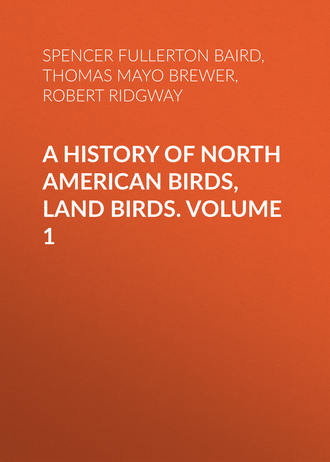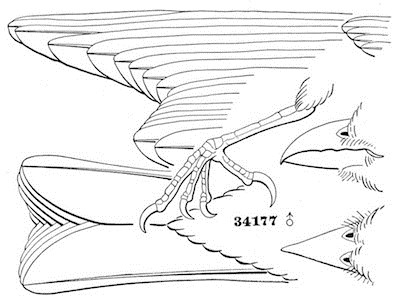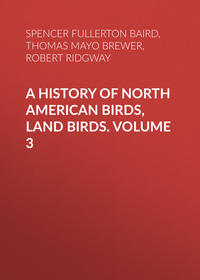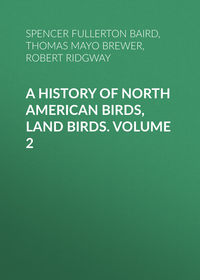 полная версия
полная версияA History of North American Birds, Land Birds. Volume 1
A. Head uniform in color with rest of upper parts; dark sooty-brown or blackish. Both webs of outer tail-feather tipped with white (except in luteola). All West Indian except luteola, which, however, occurs in Tobago and Trinidad, and generally belongs to the shores of the Carribean Sea.
1. A distinct and conspicuous external white patch at base of primaries. Wing-coverts not margined with paler.
a. Throat uniformly but decided dark ash-color, varying in shade, never entirely black, however, nor ashy-white.
Throat very dark ash, not contrasting or appreciably different from blackish of cheeks.
Wing-spot elongated; the white running out gradually and obliquely behind to the outer edge of the primary, reaching shaft of outer primary. Yellow of breast decidedly ochraceous. Rump as bright yellow as the belly. Hab. Jamaica … flaveola.83
White patch of wing more quadrate on each quill; transverse; not tapering off gradually and uniformly behind; not reaching the shaft on outer primary. Breast without ochraceous; rump olivaceous-yellow; the color different from that of belly. Hab. Santa Cruz … newtoni.84
b. Chin and throat lighter ash (but not at all whitish); in decided and appreciable contrast with blackish of cheeks. Jugulum yellow, like under parts generally.
Lateral tail-feather broadly tipped with white on both webs. Rump olivaceous-yellow.
Wing-spot on each primary nearly quadrate, as in newtoni. Hab. Porto Rico and St. Thomas … portoricensis.85
Lateral tail-feather with inner web only broadly tipped with white. Rump bright yellow like belly. Bill very small.
White of wing as in flaveola, but less extended, and margining edge only of outer primary. Hab. Hayti and St. Domingo … bananivora.86
White of wing as in newtoni. Size much larger; darker above. Hab. Tobago, Trinidad, and north shore of South America … luteola.87
c. Chin, throat, and jugulum white, with a tinge of ashy. Yellow of under parts much restricted.
Depth of bill less than half distance from nostril to tip. Superciliary stripe reaching to nape. Yellow of under part restricted to a triangular patch on breast. White spot on wing large, tapering off gradually on each primary, as in flaveola; on the outer reaching shaft. Both webs of outer tail-feather about equally tipped. Hab. Bahamas and Florida Keys … bahamensis.88
Depth of bill fully half distance from nostril to tip. Superciliary stripe reaching the occiput only. Yellow of under parts more extended. White spot on wing restricted; more quadrate, as in newtoni; edge only of outer primary involved. Outer web of outer tail-feather scarcely tipped. Hab. Cozumel Island, Yucatan … caboti.89
2. No external white patch at base of primary quills. Wing-coverts obscurely margined with paler. Both webs of outer tail-feathers tipped about equally with white. Rump olivaceous; this color of but slight extent. …
a. Throat black; continuous with black of cheeks; or else very dark plumbeous, scarcely distinguishable from the cheeks.
Median line of throat white, the sides black like the cheeks; chin alone black. Superciliary stripes not confluent anteriorly. Hab. Martinique … martinicana.90
Whole throat blackish. No white frontal band?
Wing 2.50 inches. Belly ochraceous. Hab. Dominica Island, West Indies … dominicana.91
Wing 2.20 inches. Belly more yellow. Hab. Barbadoes … barbadensis.92
Whole throat very dark plumbeous. A whitish frontal broad band connecting the superciliary stripes which extend in front of the eye. Hab. Antigua, West Indies … frontalis.93
A grayish frontal band; superciliary stripes narrow; not extending in front of eye. Trace of white patch at base of primaries … bartholemica.94
B. Head blackish, in distinct contrast to the more olivaceous back. Outer tail-feather with outer web scarcely tipped with white. Wing-coverts not margined with paler. Throat light ash, in distinct contrast to black of cheek.
1. A distinct external white wing-patch at base of primaries.
Rump olive-green. Hab. Mexico and Central America, but hardly reaching line of Panama R. R. … mexicana.95
Rump olive-yellow. Hab. Panama R. R.; south along Andes to Peru … peruviana.96
a. No external white wing-patch.
Rump olive-green. Hab. Brazil and Guiana … chloropyga.97
The preceding table is based upon a critical examination of many hundred specimens belonging to the Smithsonian Institution.—S. F. Baird.
Certhiola bahamensis, ReichBAHAMA CREEPERCerthia flaveola, var. β. Linn. Syst. Nat. ed. 12, I, 1766, 187. (“Certhia” bahamensis, Catesby, Car. tab. 59. Bahamas.) Certhiola flaveola, Baird, Birds N. Am. 1858, 924, pl. lxxxiii, f. 3 (Indian Key, Fla.). Certhiola bahamensis, Reich. Handb. I, 1853, 253 (Catesby, Car. tab. 59, Bahamas).—Cassin, Pr. A. N. S. Ph. 1864, 271. C. bairdi, Cabanis, Jour. Orn. 1865, 412 (C. flaveola, Baird, Birds N. A.).
Sp. Char. (11,951 ♂, Bahamas.) Above dark dusky-brown; scarcely darker on the head; the rump yellow. Edge of wing and a triangular patch covering the front of breast (the angle behind) pale yellow; the rest of under parts pale ashy-white, purest on front and sides of neck and on crissum; on flanks somewhat soiled and rather darker. A broad superciliary white stripe (not crossing the forehead) from bill to nape, but little lighter than the throat; the line of feathers immediately behind the nostrils, and a small patch at base of lower mandible under the tips, with the usual stripe from bill through the eye, being blackish. White spot at base of quills very distinct externally; the posterior outline on each outer web of the primaries not quadrate, but running out obliquely behind and on the outermost quill reaching the shaft. Edges of quills narrowly margined with grayish-white; on the secondaries continued round the tips. No distinct bands on the coverts. Outer tail-feathers broadly tipped with white; this even involving the innermost, but reduced to a narrow edge. Total length, 4.40; wing, 2.30; tail, 1.80.
Bill: Length from forehead, .62; from nostril, .41; along gape, .59; depth at base, .17. Legs: Tarsus, .75; middle toe and claw, .58; claw alone, .17; hind toe and claw, .45; claw alone, .20.
Hab. Bahamas and Keys of southeast coast of Florida.
A specimen from the Florida Keys (10,367) is rather darker than those from the Bahamas, the white less extended, and not quite reaching the shafts in the outer quills.
Habits. This species, belonging properly to the Bahaman group of the West Indian Islands, was found at Indian Key, Fla., January 31, 1858, by Mr. Würdemann, where it appeared to be not at all rare. Nothing is known of its habits, but they are doubtless nearly the same as those of the allied species. The C. flaveola is known in Jamaica as the Banana Quit, Honey-Sucker, and Black and Yellow Creeper. According to the description of them given by Mr. Gosse, these birds, scarcely larger than the Humming-Birds, are often seen in company with them, probing the flowers for similar purposes, but in a very different manner. Instead of hovering like the Humming-Bird in front of the blossom, for which its short wings would be incompetent, these birds alight on the tree and proceed in a very business-like manner. Hopping from twig to twig in an active manner, they carefully examine each blossom. In doing this they throw their bodies into a variety of positions, often clinging by the feet with the back downwards, the better to reach the interior of a blossom with their curved beaks and peculiar tongue. The objects of these researches are the small insects which are always found in the interior of flowers. This bird is unsuspecting and familiar, and very freely resorts to the blossoming shrubs of the gardens and yards. Mr. Gosse mentions, in evidence of this familiarity, that a large moringa-tree under his window, as he was writing, and which all through the year was profusely set with fragrant blossoms, and was a favorite resort of these birds, was being carefully scrutinized by two active little Creepers. Although within a few feet of his window, they pursued their examinations, perfectly undisturbed by his looking on. As they move about they utter a soft sibilant note.
The nests of this little bird are usually built in those low trees and bushes to which are fastened the nests of the brown wasps, and in close contiguity to them. Mr. Gosse regards this singular predilection as a remarkable exercise of instinct, if not of reason, as the evident object of it is the protection afforded by the presence of those formidable insects, though upon what terms of amity this defensive alliance is kept does not appear.
These Creepers incubate during the months of May, June, and July. On the 4th of May, Mr. Gosse observed one with a bit of “silk-cotton” in her beak, and found the skeleton of the nest just commenced in a bush of the Lantana camara. It was evidently to be of dome shape, and so far had been constructed entirely of silk-cotton. The completed nests are made in the form of a globe, with a small opening below the side. The walls are very thick, composed of dry grasses intermixed irregularly with the down of asclepias. One of these nests was fixed between the twigs of a branch of a Bauhinia projecting over a highway. Another, found towards the end of June, was built in a bush of Lantana, and of the same structure. It contained two eggs, greenish-white, thickly but indefinitely dashed with reddish at the larger end. Mr. Gosse quotes a Mr. Robinson as giving their dimensions at .44 by .31 of an inch, while his own specimens are much larger than this, measuring .63 by nearly .50. Two eggs of C. flaveola, from Jamaica, in my cabinet, measure, .68 by .51 and .68 by .49 of an inch. In one the ground is a dull white, so generally and thickly covered with minute but confluent dots of reddish-brown as to impart a pinkish tinge to the whole egg. In the other the ground is a dull white, sparingly marked with blotches of brown over about three fourths of its surface, but at the larger end covered with a crown of larger and confluent blotches of subdued purple and dark umber, intermingled with a few lines of a darker hue, almost black.
Two eggs of G. newtoni, from St. Croix, are of a more rounded-oval shape, and measure .69 by .45 and .65 by .44 of an inch. They have a dull white ground, but this is so uniformly and generally covered with confluent reddish-brown markings as to be nowhere very distinct.
The St. Croix species is called the Sugar-Bird in that island, from its habit of entering the curing-houses, through the barred windows, probably attracted thither by the swarms of flies. It is a very familiar species, haunting gardens, and often entering houses, and never manifesting any alarm. It keeps in pairs, and breeds from March to August. Mr. Newton states that it builds a domed and often pensile nest, with a small porch, or pent-house roof, over the entrance, generally at the extremity of a leafy bough. The nest is generally very untidy on the outside, and is composed of coarse grass and cotton, with feathers on the inside. It deposits its eggs before the completion of the nest, “rather to the discomfiture of the oölogist, who delays inserting his finger into the structure while he sees one or both of the birds busy with a tuft of grass or cotton in their bills, until at last he finds their eggs already hatched.” Mr. Newton observed one instance in which two broods were reared in the same nest, with only an interval of ten days between the time the young left it and the laying of an egg.
Family TANAGRIDÆ.—The Tanagers
Char. Primaries nine. Bill usually conical, sometimes depressed or attenuated, usually more or less triangular at base, and with the cutting edges not much inflected; sometimes toothed or notched. Legs short; claws curved; colors usually brilliant.
We confess our entire inability to present a diagnosis that shall define and separate satisfactorily by external characters the closely allied families of Cærebidæ, Sylvicolidæ, Tanagridæ, and Fringillidæ, agreeing as they do in the main in every respect. The only attempt at distinction is based upon the shape of the bill, and this in what are generally called Tanagridæ presents every variety of shape, from the attenuation seen in Dendroica to the stoutest form of the Fringillidæ. The Cærebidæ have peculiarities of the tongue, not appreciable, however, in the skin. In view, therefore, of the difficulty in question, we shall copy the conventional names and unsatisfactory definitions of other authors, in our inability to present a satisfactory arrangement of our own.
Carus and Gerstæcker in Handbuch der Zoologie, I, 277, adopt a classification of the Oscines based on the palatine bones in which Fringillidæ and Tanagridæ are distinguished from the Sylvicolidæ as follows:—
Suborder OSCINES, Sundevall. Of the ten primaries, the first is short, rudimentary, or wanting; the number of secondaries is rarely more than nine. Tarsus entirely booted, or else with an undivided plate on the sides. Lower trachea completely formed by the help of the trachea and bronchiæ; generally with four pairs of muscles, distributed before and behind.
Group I. Spizognathæ. Outer lamella of the palatine bone developed in a vertical plane, with the hinder border more or less emarginated; the anterior palatine process broad, and united by a truncated border to the high and broad upper mandible.
Family 1. Ploceidæ. Ten primaries.
Family 2. Fringillidæ. Bill encircled by a more or less distinct swelling at base. Frontal feathers not forming lateral angles. Edges of the jaws drawn in as far as the corner of the mouth; nine primaries; the first three usually longest. Legs with undivided plates behind.
Family 3. Tanagridæ. Bill more or less triangular at the base. Culmen always more or less curved. Frequently a tooth or notch in the upper bill, sometimes fine serrations. Wings moderate; somewhat pointed; primaries nine. Tarsus and toes short and stout. Hind toe stout and long. Claws curved.
Group II. Coræognathæ. Palatine bone broad and rather flat behind, the external angles prolonged, not extended into a vertical plate. Base of bill generally narrower. Primaries nine or ten. This section embraces, of North American forms:—
Mniotiltidæ,
Motacillidæ,
Alaudidæ,
Sylviidæ,
Turdidæ,
Cærebidæ,
Hirundinidæ,
Ampelidæ,
Laniidæ,
Troglodytidæ,
Certhiidæ,
Paridæ,
Icteridæ,
Corvidæ,
all of which have already been described in the present work, with the exception of the last two.
The family of Tanagers is peculiar to the New World, which abounds in species of a great variety of forms. Only one genus, Pyranga, actually enters within the limits of the United States, with four well-marked species, there being many others in Central and South America.
Genus PYRANGA, VieillPyranga, Vieillot, Ois. Am. Sept. I, 1807, iv.—Ib. Analyse, 1816, 32.—Sclater, Pr. Zoöl. Soc. 1856, 123.
Phœnisoma, Swainson, Class. Birds, II, 1837, 284.
Gen. Char. Bill somewhat straight; subconical, cylindrical, notched at tip; culmen moderately curved; commissure with a median acute lobe. Wings elongated; the four first primaries longest. Tail moderate, slightly forked. Colors of the male chiefly scarlet, of the female yellowish.

Pyranga rubra.
34177 ♂
The rictus is well provided with bristles, which bend downwards, but if brought forward would reach the nostrils. These are rounded, and are closely crowded by the frontal leathers. The tarsus is shorter than the middle toe, scutellate anteriorly, and smooth on the sides behind. The lateral toes are about equal; the basal joint of the middle toe united for half its length to the inner toe, and by almost the whole length to the outer.
The following table may serve to distinguish the males of the several species of this genus. The females of all differ from the males in having the red replaced, the dusky of upper surface by olive-green, the brighter tint of lower parts by yellow.—R. Ridgway.
Species and VarietiesA. Wing and tail blackish, or deep black, in more or less striking contrast to the color of the upper parts. Wing with two light bands (except in P. rubra).
a. Body and head red in the ♂; yellow in the ♀.
Wings intense black in the ♂; back not streaked.
1. P. rubra. Wing without any bands, or with merely indications of bright scarlet ones. ♂. Intense pure scarlet; wings and tail intense black. ♀. Olive-green above (including wings and tail), pale yellow below. Juv. ♀. Olive-green above, yellow below; wings and tail black. Hab. Eastern Province of United States.
2. P. erythromelæna. Wing with two bands of pure white. ♂. Bright scarlet; wings, tail, and lores intense black. ♀. Olive-green above, yellow beneath; wings and tail slaty.
Forehead, eyelids, and anterior half of cheeks velvety-black; red of a carmine shade. Hab. Middle America, north to Mirador. … var. erythromelæna.98
Forehead, eyelids, and anterior half of cheeks scarlet (lores only black); red of a scarlet shade. Hab. Northern South America. … var. ardens.99
Wings brownish-dusky in the ♂; back streaked with black.
3. P. bidentata.100 Wing with two bands of pinkish-white (♂), or yellowish-white (♀). ♂. Above reddish-brown; head and beneath minium-scarlet. ♀. Above olive-green; head and beneath yellow. Hab. Middle America (both coasts) from Costa Rica to Middle Mexico.
b. Body always yellow; head red in the ♂.
Lesser wing-coverts black or dusky4. P. ludoviciana. Wing with two light yellow bands. ♂. Back, wings, and tail intense black; head crimson. ♀. Above olive-green, tinged with ashy on the back; beneath pale greenish-yellow; wings and tail dusky olive-green; no red on head. Hab. Western Province of United States.
Lesser wing-coverts and middle coverts yellow5. P. rubriceps.101 Wing without light bands. ♂. Back and rump olive-green; wings and tail black; head crimson. Hab. New Granada.
B. Wing and tail reddish or greenish, of the same general color of the upper parts; wing without any light bands.
a. Wing, 3.00. Body always yellow; head red in the ♂.
6. P. erythrocephala.102 Above olive-green, beneath yellow. ♂. Head red. Wing, 3.00; tail, 2.70. Hab. Mexico (Temiscaltipec).
b. Wing 3.50 or more. Body and head red in ♂.
Commissure with a distinct tooth; bill bluish7. P. hepatica. Bill small, not swollen laterally; culmen gently curved terminally, straight basally; commissural tooth small. ♂. Above reddish-ashy, becoming brighter reddish on the head above; beneath minium-scarlet medially, much tinged with ashy laterally. ♀. Ashy-green and greenish-yellow, instead of reddish. Juv. ♂, similar, but throat tinged with orange-red.
Auriculars grayish like the back; eyelids light red; lores grayish. Wing, 4.10; tail, 3.40; bill, .50. Hab. Table-lands of Middle America, north into southern Rocky Mountains of United States. … var. hepatica.
Auriculars reddish like the neck; eyelids and lores well defined, buffy-white. Wing, 3.60; tail, 3.25; bill, .46. Hab. Paraguay. … var. azaræ.103
8. P. saira. Bill large, much swollen laterally, the culmen curved both terminally and basally. ♂. Above dark brownish-red, beneath deep scarlet, duller laterally. ♀. Bright olive-green and intense orange-yellow, instead of reddish.
Commissural tooth indistinct; forehead considerably brighter reddish or yellowish than the back. ♂. Beneath almost entirely pure vermilion-scarlet. ♀. Beneath almost wholly pure gamboge-yellow. Wing, 4.00; tail, 3.40; culmen, .80. Hab. Eastern South America (Brazil and Trinidad) … var. saira.104
Commissural tooth distinct, prominent; forehead scarcely brighter reddish or yellowish than the back. ♂. Beneath brownish-scarlet medially, more brownish laterally. ♀. Beneath Indian-yellow medially, greenish laterally. Wing, 3.70; tail, 3.20; culmen, .80. Hab. Southern Middle America, on the Atlantic (Belize, Rio Manati, Costa Rica, Angostura, and Veragua) … var. testacea.105
Commissure without an appreciable tooth; bill pale brownish9. P. æstiva. ♂. Above purplish-red, beneath pure, fine, rosaceous-vermilion. ♀. Above brownish olive-green, beneath ochraceous-yellow.
Head above scarcely brighter reddish or yellowish than the back. Bill, .55, or less, from nostril; primaries, .84 longer than secondaries. Wing, 3.81; tail, 2.96; bill, .52. Hab. Eastern Province of United States, south, in winter, through Eastern Middle America to Peru … var. æstiva.
Head above decidedly brighter reddish or yellowish than the back. Bill, .60 or more, from nostril; primaries, 1.16 longer than secondaries. Wing, 4.24; tail, 3.68; bill, .64. Hab. Southern Middle Province of United States (Upper Rio Grande region and Lower Colorado Basin); in winter south, through Western Mexico, to Colima … var. cooperi.
C. Body ashy; wings, tail, and pileum dull purplish-red; throat, lining of wing and crissum dilute rose-pink in the ♀.
10. P. roseigularis.106 Sides of head, nape, back, and scapulars deep ash, the dorsal region with a faint purplish cast; lores, eyelids, cheeks, and lower parts in general, paler, and with a dingy buff tinge,—paler on the abdomen, and more strongly marked with ash across the breast and along sides. Whole pileum, from bill to nape and down to the upper edge of lores, eyes, and auriculars, wings, upper tail-coverts, and tail, dark purplish-red. Whole throat dilute vermilion, or rose-pink sharply defined; crissum and lining of wings a paler shade of the same. Wing, 3.05; tail, 2.75; bill, from nostril, .45; its depth at the base, .40, its breadth, .30; tarsus, .80. Hab. Yucatan.
Pyranga rubra, VieillTHE SCARLET TANAGERTanagra rubra, Linn. I, 1766, 314.—Gmelin, I, 1788, 889.—Wilson, Am. Orn. II, 1810, 42; pl. xi, f. 3, 4.—Aud. Orn. Biog. IV, 1838, 388; pl. cccliv. Pyranga rubra, Vieillot, Ois. Am. Sept. I, 1807, iv; pl. i, f. 12 (Head.).—Swainson, F. Bor. Am. II, 1831, 273.—Bon. List. 1838.—Ib. Conspectus, 1850.—Aud. Syn. 1839, 136.—Ib. Birds Am. II, 1841, 226; pl. ccix.—Sclater, Pr. Zoöl. Soc. 1855, 156.—Ib. 1856, 123.—Max. Cab. Jour. VI, 1858, 270.—Samuels, 251. Phœnisoma rubra, Sw. Birds, II, 1837, 284. Phœnicosoma rubra, Cab. Mus. Hein. 1851, 24. Pyranga erythromelas, Vieillot, “Encyc. Méth. 800.”—Ib. Nouv. Dict. XXVIII, 1817, 293.
Sp. Char. Bill shorter than the head. Second quill longest; first and third a little shorter. Tail moderately forked. Male. Whole head and body continuous, pure, intense scarlet, the feathers white beneath the surface, and grayish at the roots. Wings and tail, with the scapulars, uniform intense black; the middle-coverts sometimes partly red, forming an interrupted band. Lining of wing white. A blackish tinge along sides of the rump, concealed by wings. Bill pea-green; iris brown; tarsi and toes dull blue. Female. Olive-green above, yellowish beneath. Wing and tail feathers brown, edged with olivaceous. Length, 7.40; wing, 4.00; tail, 3.00.
Hab. Eastern Province North America, north to Winnepeg (west to El Paso? Heermann). In winter, south to Ecuador (Rio Napo, Scl.). Bogota (Scl.) Cuba (Scl. & Gundl.); Jamaica (Scl. & Gosse); Panama (Lawr.); Costa Rica (Lawr.); Vera Cruz (winter, Sumichrast).





